Comprehensive Analysis of UK Business Taxation: VAT and More
VerifiedAdded on 2023/06/10
|40
|14658
|204
Report
AI Summary
This report provides a comprehensive overview of business taxation in the UK, focusing on self-assessment tax, VAT procedures, and corporation tax liabilities. Task 1 details the nature and purpose of self-assessment tax, determination of worker tax status, taxable amount calculations, and ethical considerations. It also evaluates taxpayer obligations and implications of non-compliance. Task 2 discusses UK tax law implications for both unincorporated and incorporated businesses, determination of capital gains taxes, chargeable gains subject to corporation taxes, adjusted profit calculations, and corporation tax liabilities. Task 3 describes VAT registration and administration procedures, computes tax under VAT schemes for small businesses, provides examples of VAT liability calculations, and discusses potential VAT penalties. The report includes practical examples and scenarios to illustrate key concepts and computations, offering valuable insights into the complexities of the UK tax system. Desklib provides access to this and other solved assignments for students.
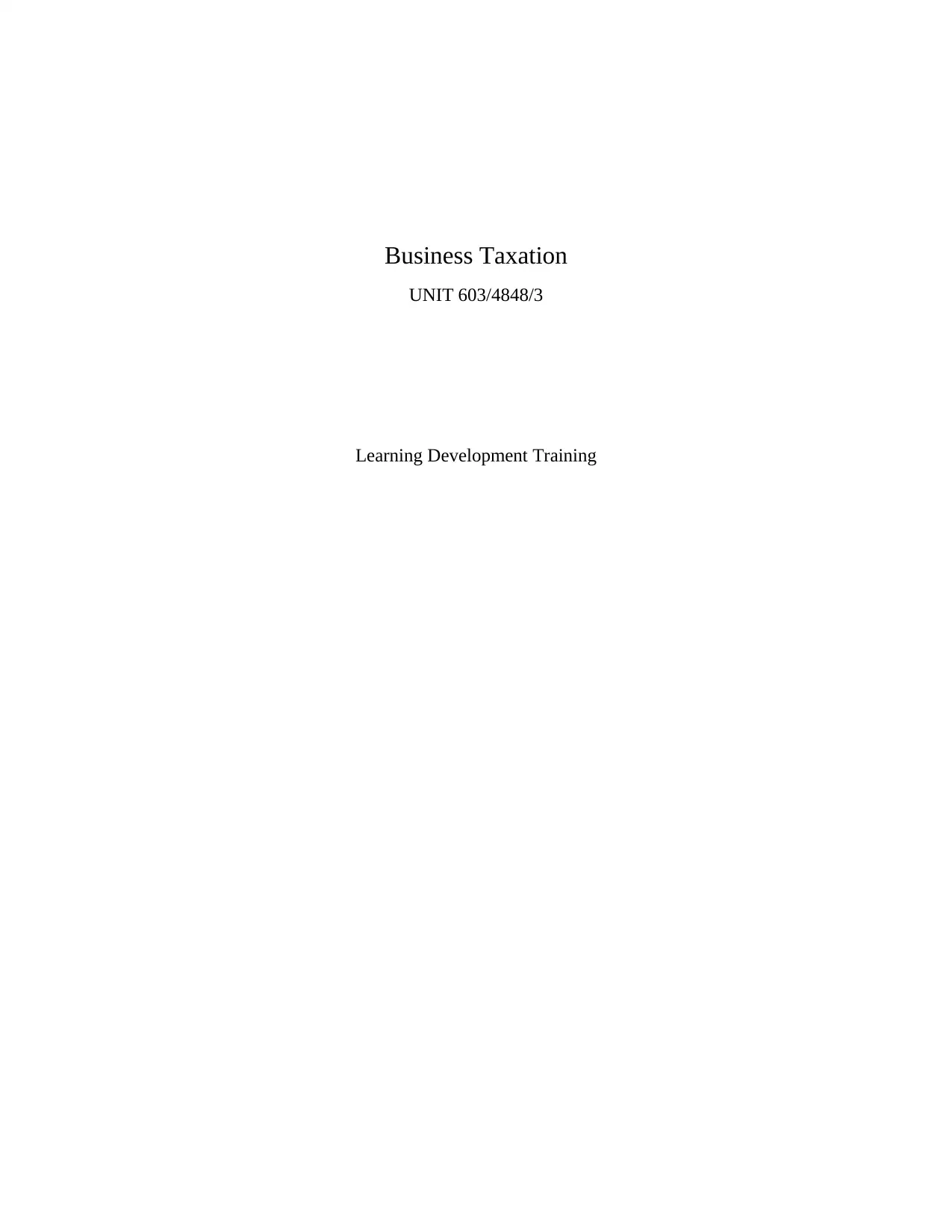
Business Taxation
UNIT 603/4848/3
Learning Development Training
UNIT 603/4848/3
Learning Development Training
Paraphrase This Document
Need a fresh take? Get an instant paraphrase of this document with our AI Paraphraser
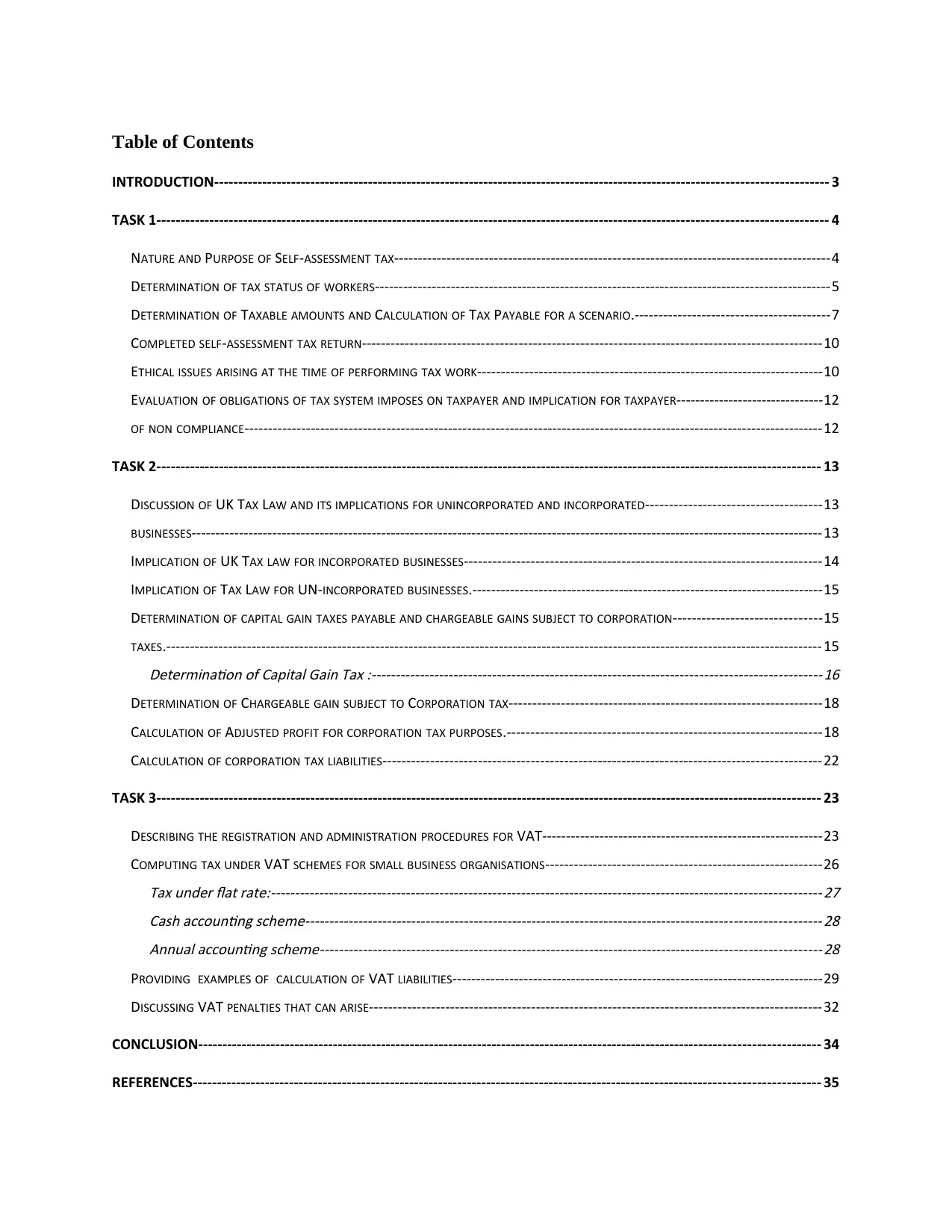
Table of Contents
INTRODUCTION------------------------------------------------------------------------------------------------------------------------------- 3
TASK 1------------------------------------------------------------------------------------------------------------------------------------------- 4
NATURE AND PURPOSE OF SELF-ASSESSMENT TAX--------------------------------------------------------------------------------------------4
DETERMINATION OF TAX STATUS OF WORKERS------------------------------------------------------------------------------------------------5
DETERMINATION OF TAXABLE AMOUNTS AND CALCULATION OF TAX PAYABLE FOR A SCENARIO.-----------------------------------------7
COMPLETED SELF-ASSESSMENT TAX RETURN-------------------------------------------------------------------------------------------------10
ETHICAL ISSUES ARISING AT THE TIME OF PERFORMING TAX WORK-------------------------------------------------------------------------10
EVALUATION OF OBLIGATIONS OF TAX SYSTEM IMPOSES ON TAXPAYER AND IMPLICATION FOR TAXPAYER-------------------------------12
OF NON COMPLIANCE--------------------------------------------------------------------------------------------------------------------------12
TASK 2------------------------------------------------------------------------------------------------------------------------------------------ 13
DISCUSSION OF UK TAX LAW AND ITS IMPLICATIONS FOR UNINCORPORATED AND INCORPORATED-------------------------------------13
BUSINESSES-------------------------------------------------------------------------------------------------------------------------------------13
IMPLICATION OF UK TAX LAW FOR INCORPORATED BUSINESSES---------------------------------------------------------------------------14
IMPLICATION OF TAX LAW FOR UN-INCORPORATED BUSINESSES.--------------------------------------------------------------------------15
DETERMINATION OF CAPITAL GAIN TAXES PAYABLE AND CHARGEABLE GAINS SUBJECT TO CORPORATION-------------------------------15
TAXES.------------------------------------------------------------------------------------------------------------------------------------------15
Determination of Capital Gain Tax :--------------------------------------------------------------------------------------------- 16
DETERMINATION OF CHARGEABLE GAIN SUBJECT TO CORPORATION TAX------------------------------------------------------------------18
CALCULATION OF ADJUSTED PROFIT FOR CORPORATION TAX PURPOSES.------------------------------------------------------------------18
CALCULATION OF CORPORATION TAX LIABILITIES--------------------------------------------------------------------------------------------22
TASK 3------------------------------------------------------------------------------------------------------------------------------------------ 23
DESCRIBING THE REGISTRATION AND ADMINISTRATION PROCEDURES FOR VAT-----------------------------------------------------------23
COMPUTING TAX UNDER VAT SCHEMES FOR SMALL BUSINESS ORGANISATIONS----------------------------------------------------------26
Tax under flat rate:------------------------------------------------------------------------------------------------------------------ 27
Cash accounting scheme----------------------------------------------------------------------------------------------------------- 28
Annual accounting scheme-------------------------------------------------------------------------------------------------------- 28
PROVIDING EXAMPLES OF CALCULATION OF VAT LIABILITIES------------------------------------------------------------------------------29
DISCUSSING VAT PENALTIES THAT CAN ARISE-----------------------------------------------------------------------------------------------32
CONCLUSION--------------------------------------------------------------------------------------------------------------------------------- 34
REFERENCES---------------------------------------------------------------------------------------------------------------------------------- 35
INTRODUCTION------------------------------------------------------------------------------------------------------------------------------- 3
TASK 1------------------------------------------------------------------------------------------------------------------------------------------- 4
NATURE AND PURPOSE OF SELF-ASSESSMENT TAX--------------------------------------------------------------------------------------------4
DETERMINATION OF TAX STATUS OF WORKERS------------------------------------------------------------------------------------------------5
DETERMINATION OF TAXABLE AMOUNTS AND CALCULATION OF TAX PAYABLE FOR A SCENARIO.-----------------------------------------7
COMPLETED SELF-ASSESSMENT TAX RETURN-------------------------------------------------------------------------------------------------10
ETHICAL ISSUES ARISING AT THE TIME OF PERFORMING TAX WORK-------------------------------------------------------------------------10
EVALUATION OF OBLIGATIONS OF TAX SYSTEM IMPOSES ON TAXPAYER AND IMPLICATION FOR TAXPAYER-------------------------------12
OF NON COMPLIANCE--------------------------------------------------------------------------------------------------------------------------12
TASK 2------------------------------------------------------------------------------------------------------------------------------------------ 13
DISCUSSION OF UK TAX LAW AND ITS IMPLICATIONS FOR UNINCORPORATED AND INCORPORATED-------------------------------------13
BUSINESSES-------------------------------------------------------------------------------------------------------------------------------------13
IMPLICATION OF UK TAX LAW FOR INCORPORATED BUSINESSES---------------------------------------------------------------------------14
IMPLICATION OF TAX LAW FOR UN-INCORPORATED BUSINESSES.--------------------------------------------------------------------------15
DETERMINATION OF CAPITAL GAIN TAXES PAYABLE AND CHARGEABLE GAINS SUBJECT TO CORPORATION-------------------------------15
TAXES.------------------------------------------------------------------------------------------------------------------------------------------15
Determination of Capital Gain Tax :--------------------------------------------------------------------------------------------- 16
DETERMINATION OF CHARGEABLE GAIN SUBJECT TO CORPORATION TAX------------------------------------------------------------------18
CALCULATION OF ADJUSTED PROFIT FOR CORPORATION TAX PURPOSES.------------------------------------------------------------------18
CALCULATION OF CORPORATION TAX LIABILITIES--------------------------------------------------------------------------------------------22
TASK 3------------------------------------------------------------------------------------------------------------------------------------------ 23
DESCRIBING THE REGISTRATION AND ADMINISTRATION PROCEDURES FOR VAT-----------------------------------------------------------23
COMPUTING TAX UNDER VAT SCHEMES FOR SMALL BUSINESS ORGANISATIONS----------------------------------------------------------26
Tax under flat rate:------------------------------------------------------------------------------------------------------------------ 27
Cash accounting scheme----------------------------------------------------------------------------------------------------------- 28
Annual accounting scheme-------------------------------------------------------------------------------------------------------- 28
PROVIDING EXAMPLES OF CALCULATION OF VAT LIABILITIES------------------------------------------------------------------------------29
DISCUSSING VAT PENALTIES THAT CAN ARISE-----------------------------------------------------------------------------------------------32
CONCLUSION--------------------------------------------------------------------------------------------------------------------------------- 34
REFERENCES---------------------------------------------------------------------------------------------------------------------------------- 35

APPENDIX------------------------------------------------------------------------------------------------------------------------------------- 38
ADDITIONAL INFORMATION-------------------------------------------------------------------------------------------------------------------39
Investment Income------------------------------------------------------------------------------------------------------------------ 39
ADDITIONAL INFORMATION-------------------------------------------------------------------------------------------------------------------39
Investment Income------------------------------------------------------------------------------------------------------------------ 39
⊘ This is a preview!⊘
Do you want full access?
Subscribe today to unlock all pages.

Trusted by 1+ million students worldwide
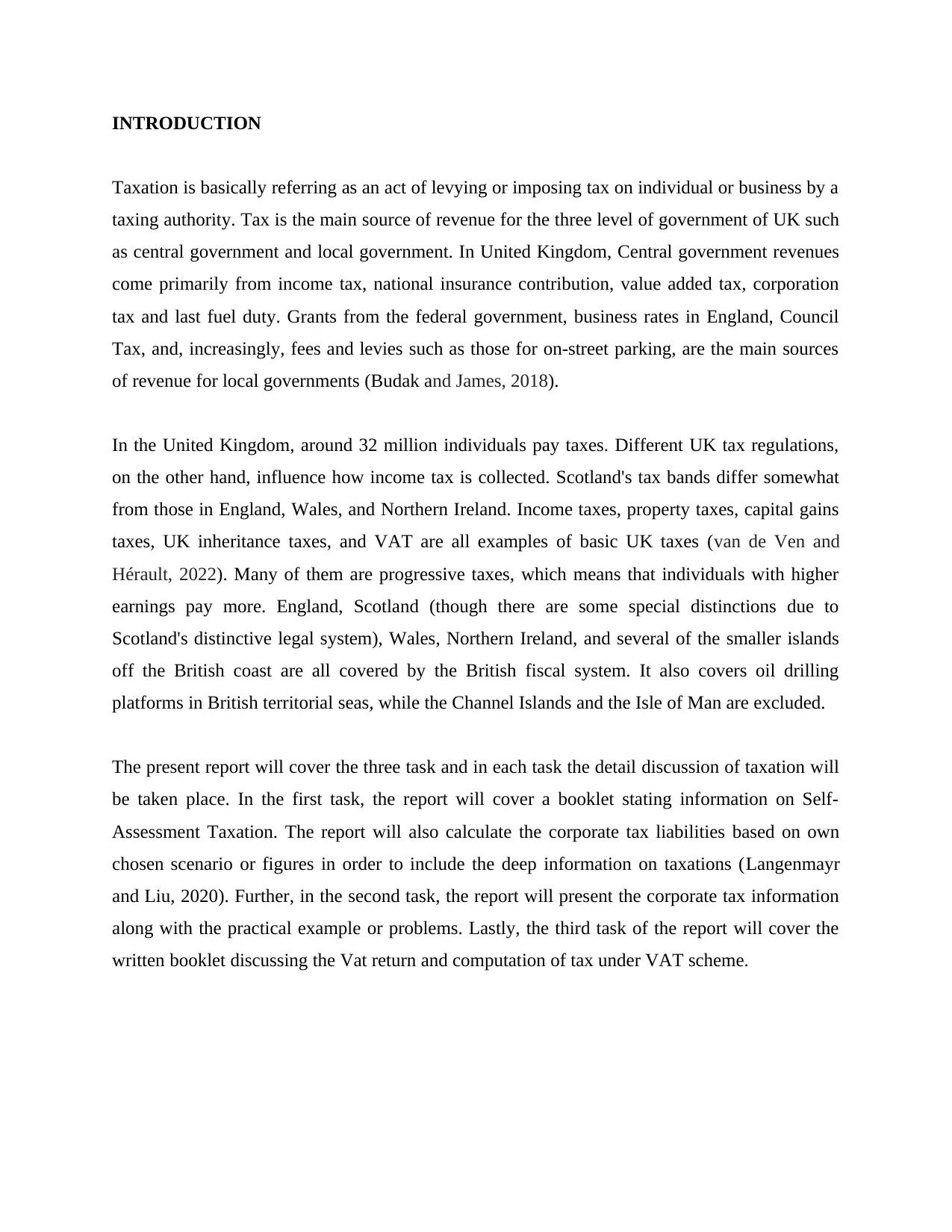
INTRODUCTION
Taxation is basically referring as an act of levying or imposing tax on individual or business by a
taxing authority. Tax is the main source of revenue for the three level of government of UK such
as central government and local government. In United Kingdom, Central government revenues
come primarily from income tax, national insurance contribution, value added tax, corporation
tax and last fuel duty. Grants from the federal government, business rates in England, Council
Tax, and, increasingly, fees and levies such as those for on-street parking, are the main sources
of revenue for local governments (Budak and James, 2018).
In the United Kingdom, around 32 million individuals pay taxes. Different UK tax regulations,
on the other hand, influence how income tax is collected. Scotland's tax bands differ somewhat
from those in England, Wales, and Northern Ireland. Income taxes, property taxes, capital gains
taxes, UK inheritance taxes, and VAT are all examples of basic UK taxes (van de Ven and
Hérault, 2022). Many of them are progressive taxes, which means that individuals with higher
earnings pay more. England, Scotland (though there are some special distinctions due to
Scotland's distinctive legal system), Wales, Northern Ireland, and several of the smaller islands
off the British coast are all covered by the British fiscal system. It also covers oil drilling
platforms in British territorial seas, while the Channel Islands and the Isle of Man are excluded.
The present report will cover the three task and in each task the detail discussion of taxation will
be taken place. In the first task, the report will cover a booklet stating information on Self-
Assessment Taxation. The report will also calculate the corporate tax liabilities based on own
chosen scenario or figures in order to include the deep information on taxations (Langenmayr
and Liu, 2020). Further, in the second task, the report will present the corporate tax information
along with the practical example or problems. Lastly, the third task of the report will cover the
written booklet discussing the Vat return and computation of tax under VAT scheme.
Taxation is basically referring as an act of levying or imposing tax on individual or business by a
taxing authority. Tax is the main source of revenue for the three level of government of UK such
as central government and local government. In United Kingdom, Central government revenues
come primarily from income tax, national insurance contribution, value added tax, corporation
tax and last fuel duty. Grants from the federal government, business rates in England, Council
Tax, and, increasingly, fees and levies such as those for on-street parking, are the main sources
of revenue for local governments (Budak and James, 2018).
In the United Kingdom, around 32 million individuals pay taxes. Different UK tax regulations,
on the other hand, influence how income tax is collected. Scotland's tax bands differ somewhat
from those in England, Wales, and Northern Ireland. Income taxes, property taxes, capital gains
taxes, UK inheritance taxes, and VAT are all examples of basic UK taxes (van de Ven and
Hérault, 2022). Many of them are progressive taxes, which means that individuals with higher
earnings pay more. England, Scotland (though there are some special distinctions due to
Scotland's distinctive legal system), Wales, Northern Ireland, and several of the smaller islands
off the British coast are all covered by the British fiscal system. It also covers oil drilling
platforms in British territorial seas, while the Channel Islands and the Isle of Man are excluded.
The present report will cover the three task and in each task the detail discussion of taxation will
be taken place. In the first task, the report will cover a booklet stating information on Self-
Assessment Taxation. The report will also calculate the corporate tax liabilities based on own
chosen scenario or figures in order to include the deep information on taxations (Langenmayr
and Liu, 2020). Further, in the second task, the report will present the corporate tax information
along with the practical example or problems. Lastly, the third task of the report will cover the
written booklet discussing the Vat return and computation of tax under VAT scheme.
Paraphrase This Document
Need a fresh take? Get an instant paraphrase of this document with our AI Paraphraser
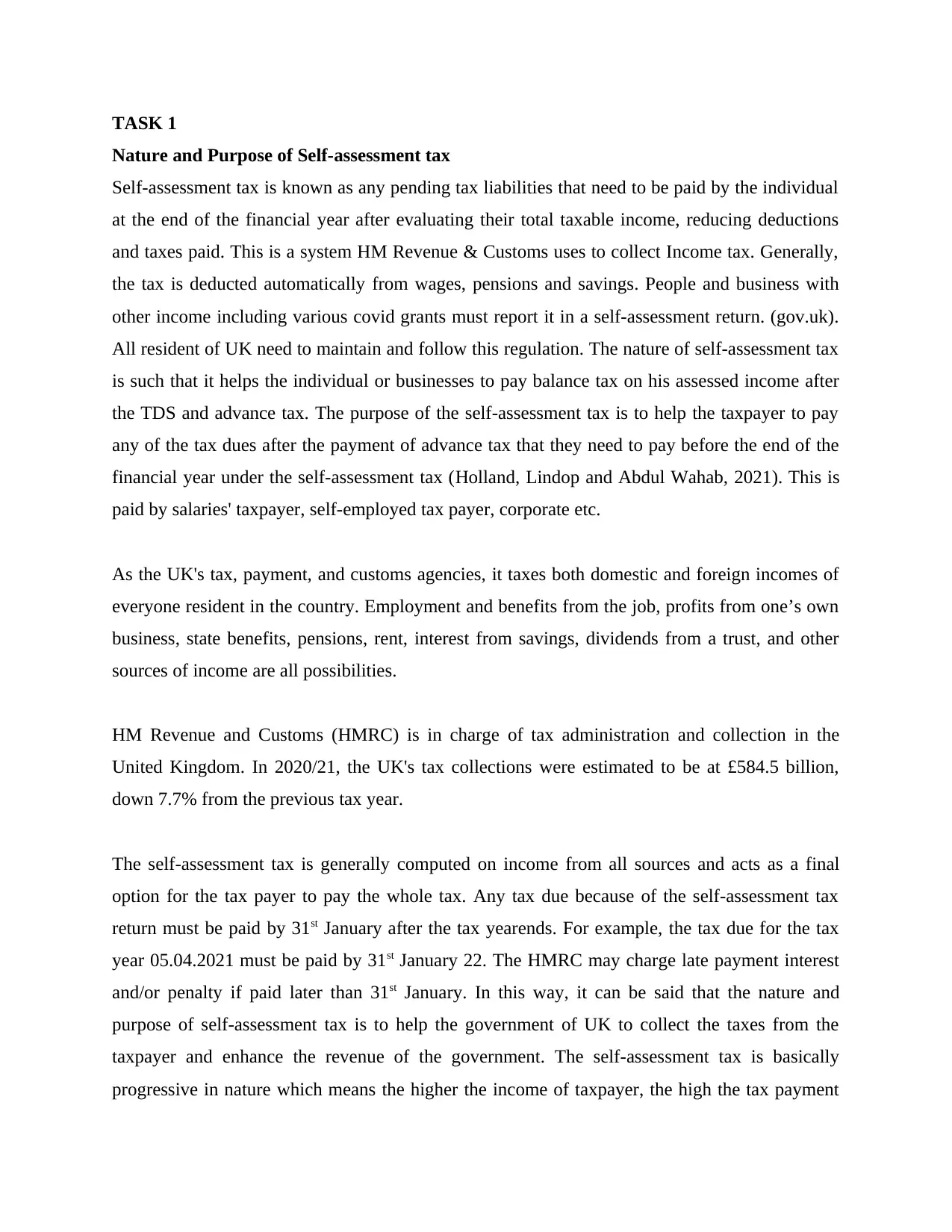
TASK 1
Nature and Purpose of Self-assessment tax
Self-assessment tax is known as any pending tax liabilities that need to be paid by the individual
at the end of the financial year after evaluating their total taxable income, reducing deductions
and taxes paid. This is a system HM Revenue & Customs uses to collect Income tax. Generally,
the tax is deducted automatically from wages, pensions and savings. People and business with
other income including various covid grants must report it in a self-assessment return. (gov.uk).
All resident of UK need to maintain and follow this regulation. The nature of self-assessment tax
is such that it helps the individual or businesses to pay balance tax on his assessed income after
the TDS and advance tax. The purpose of the self-assessment tax is to help the taxpayer to pay
any of the tax dues after the payment of advance tax that they need to pay before the end of the
financial year under the self-assessment tax (Holland, Lindop and Abdul Wahab, 2021). This is
paid by salaries' taxpayer, self-employed tax payer, corporate etc.
As the UK's tax, payment, and customs agencies, it taxes both domestic and foreign incomes of
everyone resident in the country. Employment and benefits from the job, profits from one’s own
business, state benefits, pensions, rent, interest from savings, dividends from a trust, and other
sources of income are all possibilities.
HM Revenue and Customs (HMRC) is in charge of tax administration and collection in the
United Kingdom. In 2020/21, the UK's tax collections were estimated to be at £584.5 billion,
down 7.7% from the previous tax year.
The self-assessment tax is generally computed on income from all sources and acts as a final
option for the tax payer to pay the whole tax. Any tax due because of the self-assessment tax
return must be paid by 31st January after the tax yearends. For example, the tax due for the tax
year 05.04.2021 must be paid by 31st January 22. The HMRC may charge late payment interest
and/or penalty if paid later than 31st January. In this way, it can be said that the nature and
purpose of self-assessment tax is to help the government of UK to collect the taxes from the
taxpayer and enhance the revenue of the government. The self-assessment tax is basically
progressive in nature which means the higher the income of taxpayer, the high the tax payment
Nature and Purpose of Self-assessment tax
Self-assessment tax is known as any pending tax liabilities that need to be paid by the individual
at the end of the financial year after evaluating their total taxable income, reducing deductions
and taxes paid. This is a system HM Revenue & Customs uses to collect Income tax. Generally,
the tax is deducted automatically from wages, pensions and savings. People and business with
other income including various covid grants must report it in a self-assessment return. (gov.uk).
All resident of UK need to maintain and follow this regulation. The nature of self-assessment tax
is such that it helps the individual or businesses to pay balance tax on his assessed income after
the TDS and advance tax. The purpose of the self-assessment tax is to help the taxpayer to pay
any of the tax dues after the payment of advance tax that they need to pay before the end of the
financial year under the self-assessment tax (Holland, Lindop and Abdul Wahab, 2021). This is
paid by salaries' taxpayer, self-employed tax payer, corporate etc.
As the UK's tax, payment, and customs agencies, it taxes both domestic and foreign incomes of
everyone resident in the country. Employment and benefits from the job, profits from one’s own
business, state benefits, pensions, rent, interest from savings, dividends from a trust, and other
sources of income are all possibilities.
HM Revenue and Customs (HMRC) is in charge of tax administration and collection in the
United Kingdom. In 2020/21, the UK's tax collections were estimated to be at £584.5 billion,
down 7.7% from the previous tax year.
The self-assessment tax is generally computed on income from all sources and acts as a final
option for the tax payer to pay the whole tax. Any tax due because of the self-assessment tax
return must be paid by 31st January after the tax yearends. For example, the tax due for the tax
year 05.04.2021 must be paid by 31st January 22. The HMRC may charge late payment interest
and/or penalty if paid later than 31st January. In this way, it can be said that the nature and
purpose of self-assessment tax is to help the government of UK to collect the taxes from the
taxpayer and enhance the revenue of the government. The self-assessment tax is basically
progressive in nature which means the higher the income of taxpayer, the high the tax payment
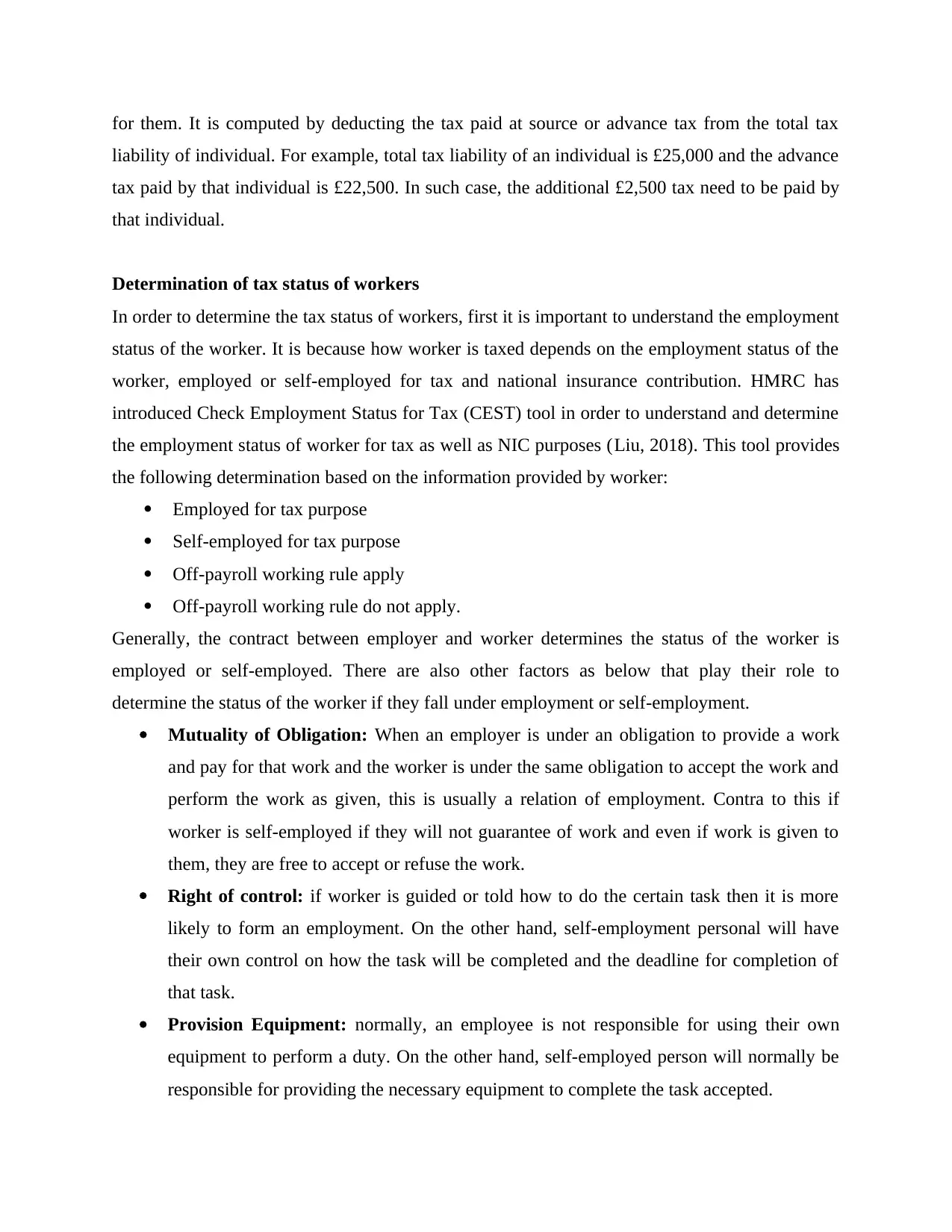
for them. It is computed by deducting the tax paid at source or advance tax from the total tax
liability of individual. For example, total tax liability of an individual is £25,000 and the advance
tax paid by that individual is £22,500. In such case, the additional £2,500 tax need to be paid by
that individual.
Determination of tax status of workers
In order to determine the tax status of workers, first it is important to understand the employment
status of the worker. It is because how worker is taxed depends on the employment status of the
worker, employed or self-employed for tax and national insurance contribution. HMRC has
introduced Check Employment Status for Tax (CEST) tool in order to understand and determine
the employment status of worker for tax as well as NIC purposes (Liu, 2018). This tool provides
the following determination based on the information provided by worker:
Employed for tax purpose
Self-employed for tax purpose
Off-payroll working rule apply
Off-payroll working rule do not apply.
Generally, the contract between employer and worker determines the status of the worker is
employed or self-employed. There are also other factors as below that play their role to
determine the status of the worker if they fall under employment or self-employment.
Mutuality of Obligation: When an employer is under an obligation to provide a work
and pay for that work and the worker is under the same obligation to accept the work and
perform the work as given, this is usually a relation of employment. Contra to this if
worker is self-employed if they will not guarantee of work and even if work is given to
them, they are free to accept or refuse the work.
Right of control: if worker is guided or told how to do the certain task then it is more
likely to form an employment. On the other hand, self-employment personal will have
their own control on how the task will be completed and the deadline for completion of
that task.
Provision Equipment: normally, an employee is not responsible for using their own
equipment to perform a duty. On the other hand, self-employed person will normally be
responsible for providing the necessary equipment to complete the task accepted.
liability of individual. For example, total tax liability of an individual is £25,000 and the advance
tax paid by that individual is £22,500. In such case, the additional £2,500 tax need to be paid by
that individual.
Determination of tax status of workers
In order to determine the tax status of workers, first it is important to understand the employment
status of the worker. It is because how worker is taxed depends on the employment status of the
worker, employed or self-employed for tax and national insurance contribution. HMRC has
introduced Check Employment Status for Tax (CEST) tool in order to understand and determine
the employment status of worker for tax as well as NIC purposes (Liu, 2018). This tool provides
the following determination based on the information provided by worker:
Employed for tax purpose
Self-employed for tax purpose
Off-payroll working rule apply
Off-payroll working rule do not apply.
Generally, the contract between employer and worker determines the status of the worker is
employed or self-employed. There are also other factors as below that play their role to
determine the status of the worker if they fall under employment or self-employment.
Mutuality of Obligation: When an employer is under an obligation to provide a work
and pay for that work and the worker is under the same obligation to accept the work and
perform the work as given, this is usually a relation of employment. Contra to this if
worker is self-employed if they will not guarantee of work and even if work is given to
them, they are free to accept or refuse the work.
Right of control: if worker is guided or told how to do the certain task then it is more
likely to form an employment. On the other hand, self-employment personal will have
their own control on how the task will be completed and the deadline for completion of
that task.
Provision Equipment: normally, an employee is not responsible for using their own
equipment to perform a duty. On the other hand, self-employed person will normally be
responsible for providing the necessary equipment to complete the task accepted.
⊘ This is a preview!⊘
Do you want full access?
Subscribe today to unlock all pages.

Trusted by 1+ million students worldwide
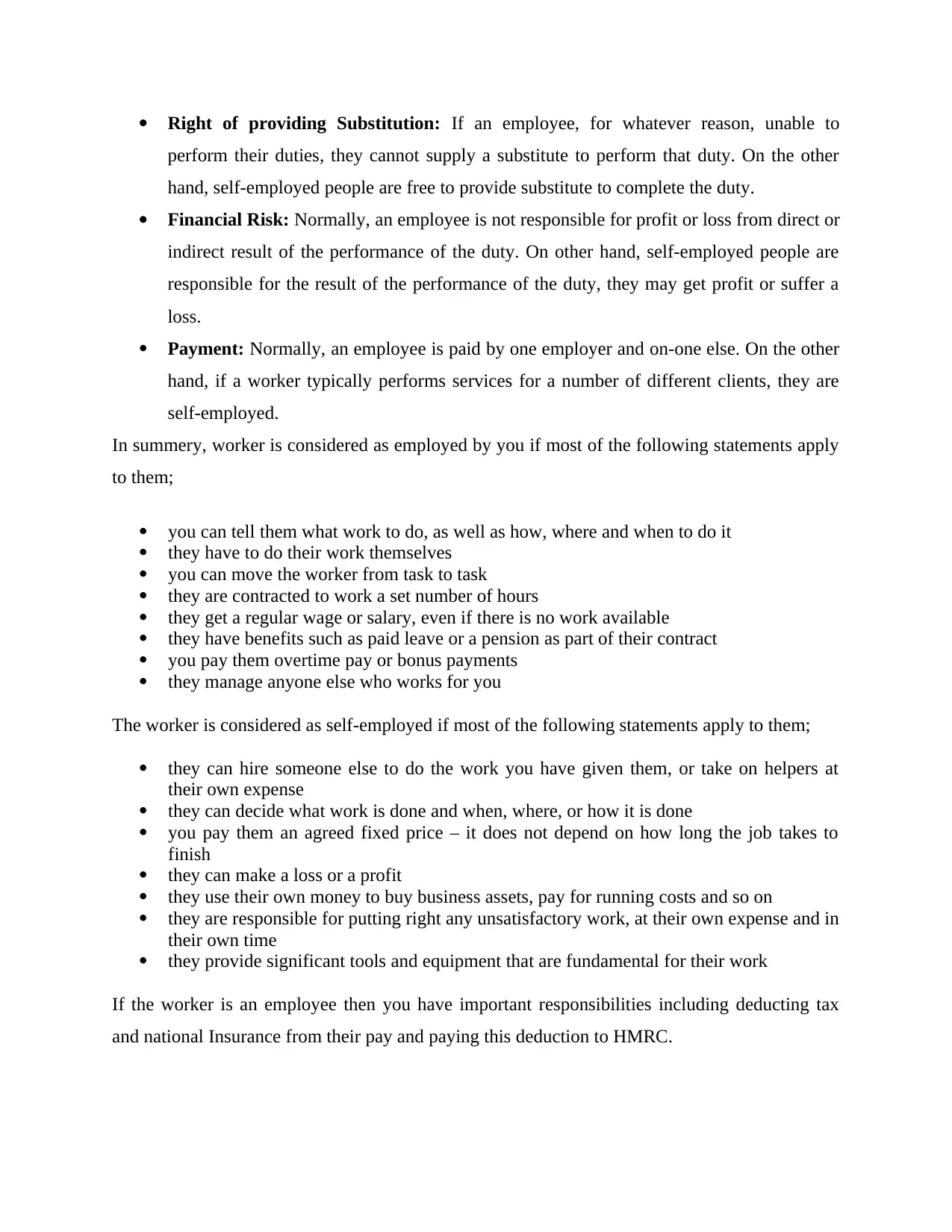
Right of providing Substitution: If an employee, for whatever reason, unable to
perform their duties, they cannot supply a substitute to perform that duty. On the other
hand, self-employed people are free to provide substitute to complete the duty.
Financial Risk: Normally, an employee is not responsible for profit or loss from direct or
indirect result of the performance of the duty. On other hand, self-employed people are
responsible for the result of the performance of the duty, they may get profit or suffer a
loss.
Payment: Normally, an employee is paid by one employer and on-one else. On the other
hand, if a worker typically performs services for a number of different clients, they are
self-employed.
In summery, worker is considered as employed by you if most of the following statements apply
to them;
you can tell them what work to do, as well as how, where and when to do it
they have to do their work themselves
you can move the worker from task to task
they are contracted to work a set number of hours
they get a regular wage or salary, even if there is no work available
they have benefits such as paid leave or a pension as part of their contract
you pay them overtime pay or bonus payments
they manage anyone else who works for you
The worker is considered as self-employed if most of the following statements apply to them;
they can hire someone else to do the work you have given them, or take on helpers at
their own expense
they can decide what work is done and when, where, or how it is done
you pay them an agreed fixed price – it does not depend on how long the job takes to
finish
they can make a loss or a profit
they use their own money to buy business assets, pay for running costs and so on
they are responsible for putting right any unsatisfactory work, at their own expense and in
their own time
they provide significant tools and equipment that are fundamental for their work
If the worker is an employee then you have important responsibilities including deducting tax
and national Insurance from their pay and paying this deduction to HMRC.
perform their duties, they cannot supply a substitute to perform that duty. On the other
hand, self-employed people are free to provide substitute to complete the duty.
Financial Risk: Normally, an employee is not responsible for profit or loss from direct or
indirect result of the performance of the duty. On other hand, self-employed people are
responsible for the result of the performance of the duty, they may get profit or suffer a
loss.
Payment: Normally, an employee is paid by one employer and on-one else. On the other
hand, if a worker typically performs services for a number of different clients, they are
self-employed.
In summery, worker is considered as employed by you if most of the following statements apply
to them;
you can tell them what work to do, as well as how, where and when to do it
they have to do their work themselves
you can move the worker from task to task
they are contracted to work a set number of hours
they get a regular wage or salary, even if there is no work available
they have benefits such as paid leave or a pension as part of their contract
you pay them overtime pay or bonus payments
they manage anyone else who works for you
The worker is considered as self-employed if most of the following statements apply to them;
they can hire someone else to do the work you have given them, or take on helpers at
their own expense
they can decide what work is done and when, where, or how it is done
you pay them an agreed fixed price – it does not depend on how long the job takes to
finish
they can make a loss or a profit
they use their own money to buy business assets, pay for running costs and so on
they are responsible for putting right any unsatisfactory work, at their own expense and in
their own time
they provide significant tools and equipment that are fundamental for their work
If the worker is an employee then you have important responsibilities including deducting tax
and national Insurance from their pay and paying this deduction to HMRC.
Paraphrase This Document
Need a fresh take? Get an instant paraphrase of this document with our AI Paraphraser
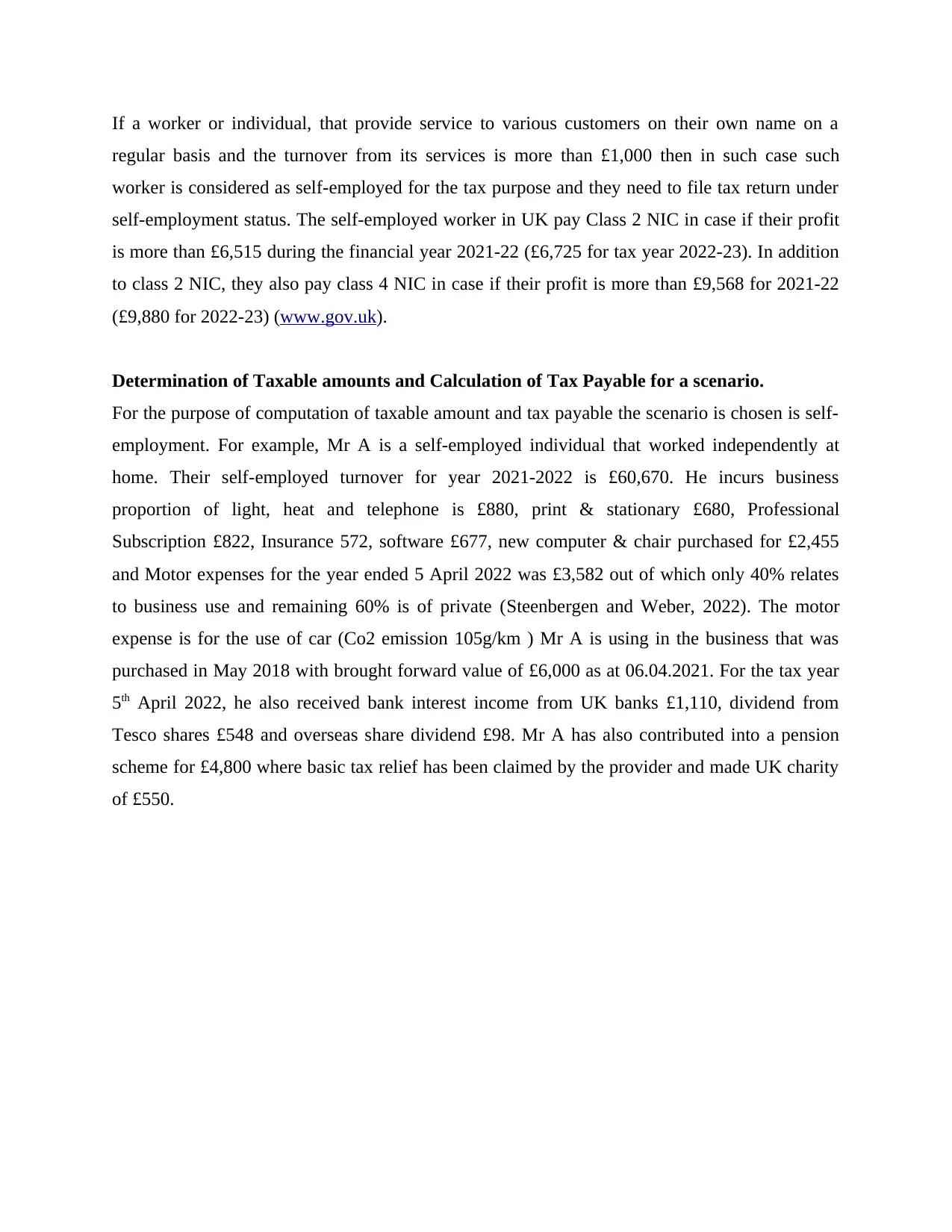
If a worker or individual, that provide service to various customers on their own name on a
regular basis and the turnover from its services is more than £1,000 then in such case such
worker is considered as self-employed for the tax purpose and they need to file tax return under
self-employment status. The self-employed worker in UK pay Class 2 NIC in case if their profit
is more than £6,515 during the financial year 2021-22 (£6,725 for tax year 2022-23). In addition
to class 2 NIC, they also pay class 4 NIC in case if their profit is more than £9,568 for 2021-22
(£9,880 for 2022-23) (www.gov.uk).
Determination of Taxable amounts and Calculation of Tax Payable for a scenario.
For the purpose of computation of taxable amount and tax payable the scenario is chosen is self-
employment. For example, Mr A is a self-employed individual that worked independently at
home. Their self-employed turnover for year 2021-2022 is £60,670. He incurs business
proportion of light, heat and telephone is £880, print & stationary £680, Professional
Subscription £822, Insurance 572, software £677, new computer & chair purchased for £2,455
and Motor expenses for the year ended 5 April 2022 was £3,582 out of which only 40% relates
to business use and remaining 60% is of private (Steenbergen and Weber, 2022). The motor
expense is for the use of car (Co2 emission 105g/km ) Mr A is using in the business that was
purchased in May 2018 with brought forward value of £6,000 as at 06.04.2021. For the tax year
5th April 2022, he also received bank interest income from UK banks £1,110, dividend from
Tesco shares £548 and overseas share dividend £98. Mr A has also contributed into a pension
scheme for £4,800 where basic tax relief has been claimed by the provider and made UK charity
of £550.
regular basis and the turnover from its services is more than £1,000 then in such case such
worker is considered as self-employed for the tax purpose and they need to file tax return under
self-employment status. The self-employed worker in UK pay Class 2 NIC in case if their profit
is more than £6,515 during the financial year 2021-22 (£6,725 for tax year 2022-23). In addition
to class 2 NIC, they also pay class 4 NIC in case if their profit is more than £9,568 for 2021-22
(£9,880 for 2022-23) (www.gov.uk).
Determination of Taxable amounts and Calculation of Tax Payable for a scenario.
For the purpose of computation of taxable amount and tax payable the scenario is chosen is self-
employment. For example, Mr A is a self-employed individual that worked independently at
home. Their self-employed turnover for year 2021-2022 is £60,670. He incurs business
proportion of light, heat and telephone is £880, print & stationary £680, Professional
Subscription £822, Insurance 572, software £677, new computer & chair purchased for £2,455
and Motor expenses for the year ended 5 April 2022 was £3,582 out of which only 40% relates
to business use and remaining 60% is of private (Steenbergen and Weber, 2022). The motor
expense is for the use of car (Co2 emission 105g/km ) Mr A is using in the business that was
purchased in May 2018 with brought forward value of £6,000 as at 06.04.2021. For the tax year
5th April 2022, he also received bank interest income from UK banks £1,110, dividend from
Tesco shares £548 and overseas share dividend £98. Mr A has also contributed into a pension
scheme for £4,800 where basic tax relief has been claimed by the provider and made UK charity
of £550.
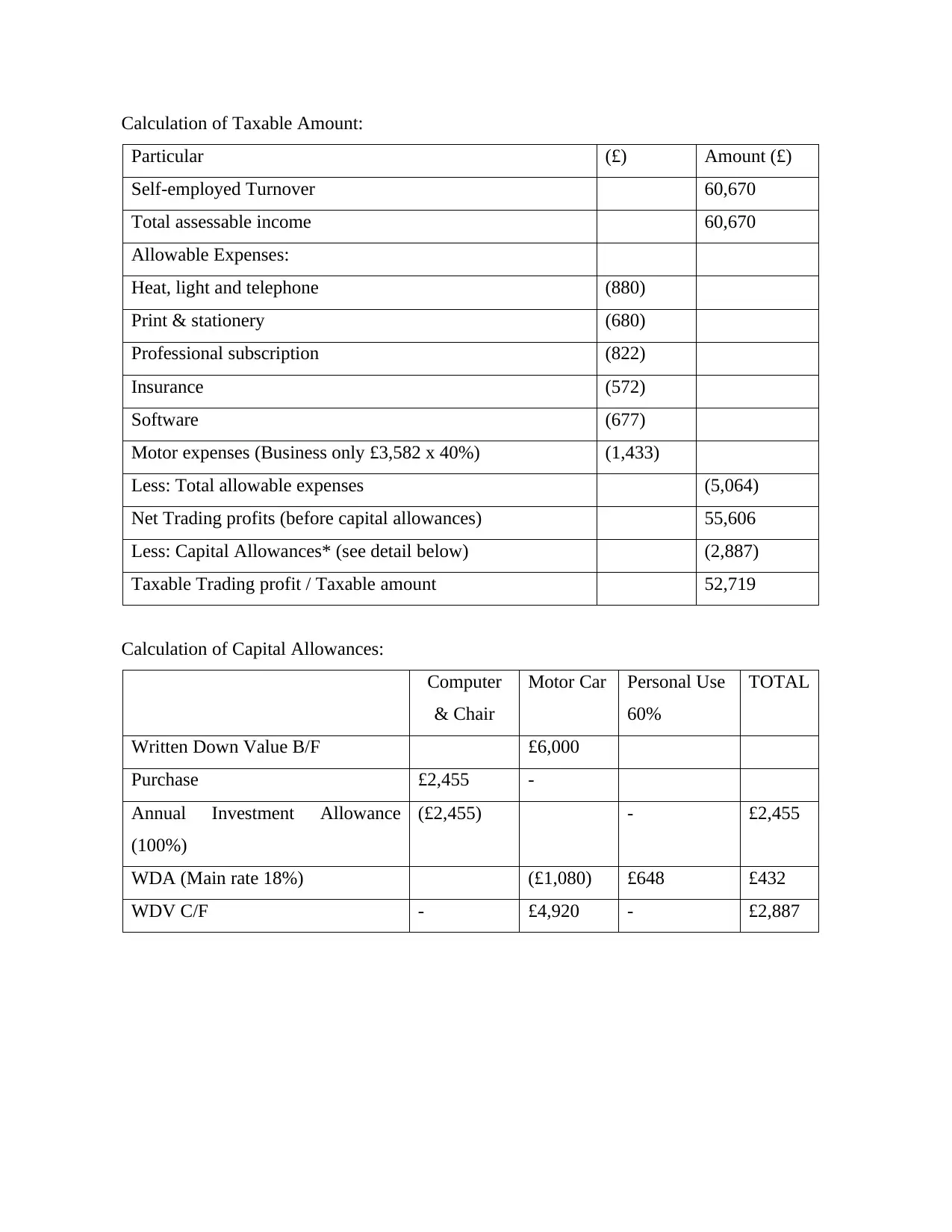
Calculation of Taxable Amount:
Particular (£) Amount (£)
Self-employed Turnover 60,670
Total assessable income 60,670
Allowable Expenses:
Heat, light and telephone (880)
Print & stationery (680)
Professional subscription (822)
Insurance (572)
Software (677)
Motor expenses (Business only £3,582 x 40%) (1,433)
Less: Total allowable expenses (5,064)
Net Trading profits (before capital allowances) 55,606
Less: Capital Allowances* (see detail below) (2,887)
Taxable Trading profit / Taxable amount 52,719
Calculation of Capital Allowances:
Computer
& Chair
Motor Car Personal Use
60%
TOTAL
Written Down Value B/F £6,000
Purchase £2,455 -
Annual Investment Allowance
(100%)
(£2,455) - £2,455
WDA (Main rate 18%) (£1,080) £648 £432
WDV C/F - £4,920 - £2,887
Particular (£) Amount (£)
Self-employed Turnover 60,670
Total assessable income 60,670
Allowable Expenses:
Heat, light and telephone (880)
Print & stationery (680)
Professional subscription (822)
Insurance (572)
Software (677)
Motor expenses (Business only £3,582 x 40%) (1,433)
Less: Total allowable expenses (5,064)
Net Trading profits (before capital allowances) 55,606
Less: Capital Allowances* (see detail below) (2,887)
Taxable Trading profit / Taxable amount 52,719
Calculation of Capital Allowances:
Computer
& Chair
Motor Car Personal Use
60%
TOTAL
Written Down Value B/F £6,000
Purchase £2,455 -
Annual Investment Allowance
(100%)
(£2,455) - £2,455
WDA (Main rate 18%) (£1,080) £648 £432
WDV C/F - £4,920 - £2,887
⊘ This is a preview!⊘
Do you want full access?
Subscribe today to unlock all pages.

Trusted by 1+ million students worldwide
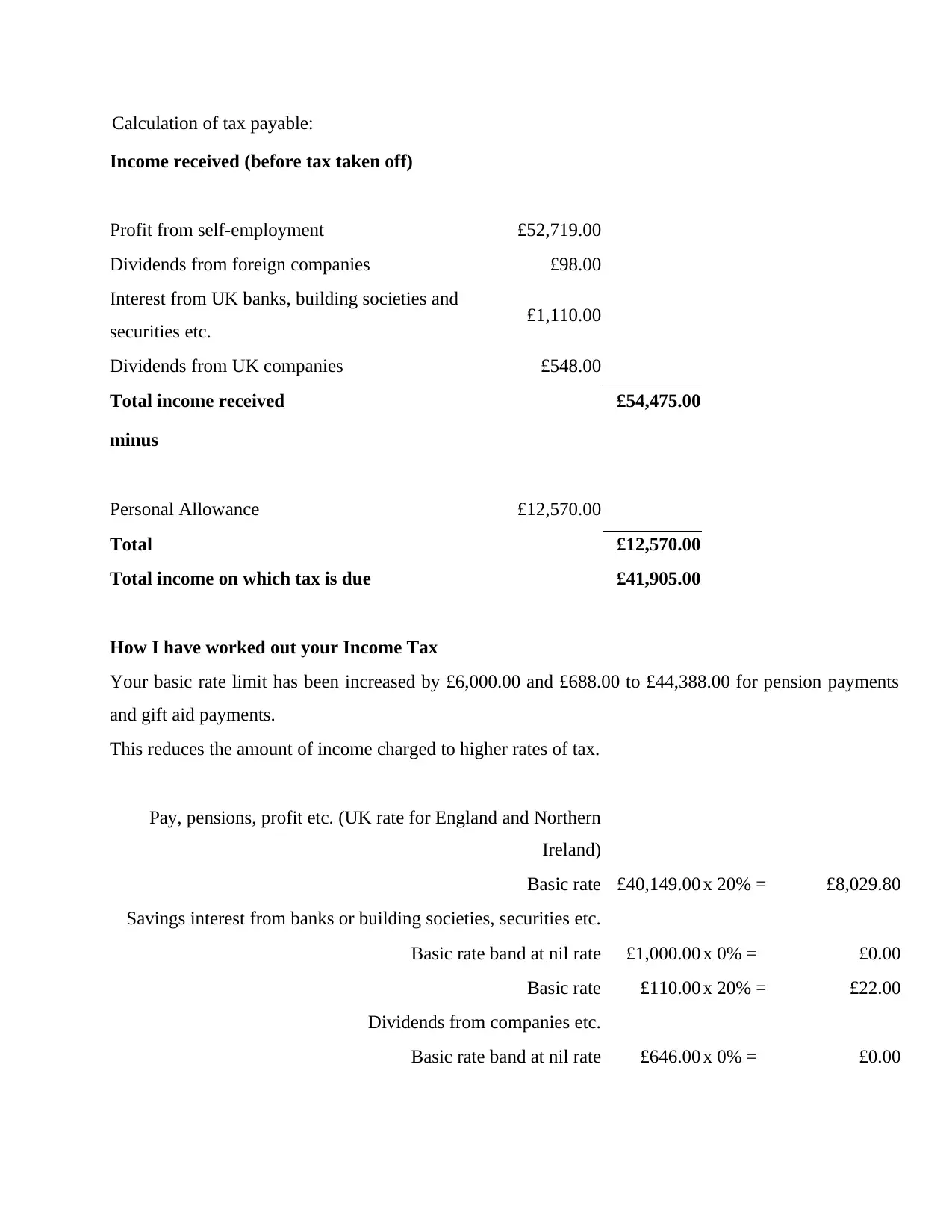
Calculation of tax payable:
Income received (before tax taken off)
Profit from self-employment £52,719.00
Dividends from foreign companies £98.00
Interest from UK banks, building societies and
securities etc. £1,110.00
Dividends from UK companies £548.00
Total income received £54,475.00
minus
Personal Allowance £12,570.00
Total £12,570.00
Total income on which tax is due £41,905.00
How I have worked out your Income Tax
Your basic rate limit has been increased by £6,000.00 and £688.00 to £44,388.00 for pension payments
and gift aid payments.
This reduces the amount of income charged to higher rates of tax.
Pay, pensions, profit etc. (UK rate for England and Northern
Ireland)
Basic rate £40,149.00 x 20% = £8,029.80
Savings interest from banks or building societies, securities etc.
Basic rate band at nil rate £1,000.00 x 0% = £0.00
Basic rate £110.00 x 20% = £22.00
Dividends from companies etc.
Basic rate band at nil rate £646.00 x 0% = £0.00
Income received (before tax taken off)
Profit from self-employment £52,719.00
Dividends from foreign companies £98.00
Interest from UK banks, building societies and
securities etc. £1,110.00
Dividends from UK companies £548.00
Total income received £54,475.00
minus
Personal Allowance £12,570.00
Total £12,570.00
Total income on which tax is due £41,905.00
How I have worked out your Income Tax
Your basic rate limit has been increased by £6,000.00 and £688.00 to £44,388.00 for pension payments
and gift aid payments.
This reduces the amount of income charged to higher rates of tax.
Pay, pensions, profit etc. (UK rate for England and Northern
Ireland)
Basic rate £40,149.00 x 20% = £8,029.80
Savings interest from banks or building societies, securities etc.
Basic rate band at nil rate £1,000.00 x 0% = £0.00
Basic rate £110.00 x 20% = £22.00
Dividends from companies etc.
Basic rate band at nil rate £646.00 x 0% = £0.00
Paraphrase This Document
Need a fresh take? Get an instant paraphrase of this document with our AI Paraphraser
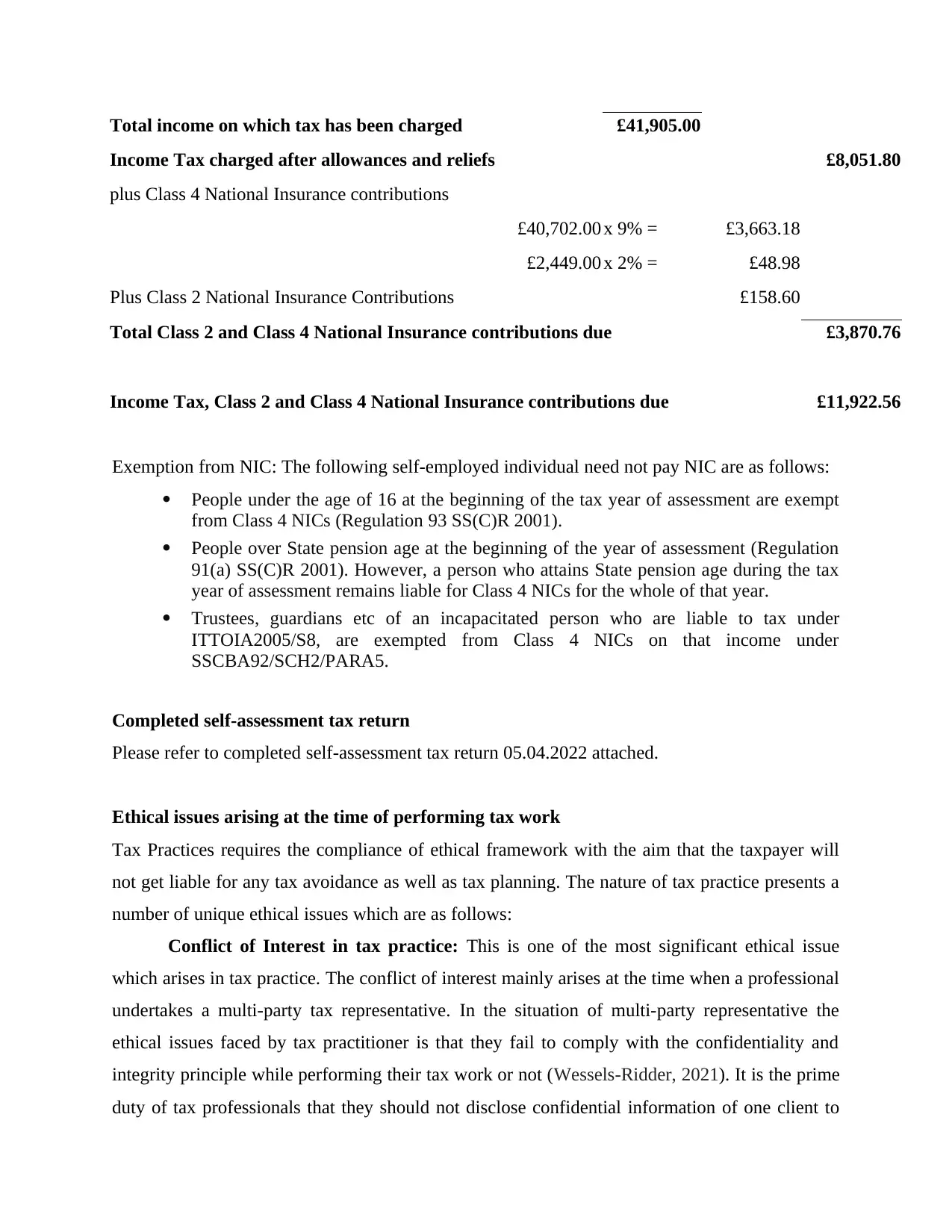
Total income on which tax has been charged £41,905.00
Income Tax charged after allowances and reliefs £8,051.80
plus Class 4 National Insurance contributions
£40,702.00 x 9% = £3,663.18
£2,449.00 x 2% = £48.98
Plus Class 2 National Insurance Contributions £158.60
Total Class 2 and Class 4 National Insurance contributions due £3,870.76
Income Tax, Class 2 and Class 4 National Insurance contributions due £11,922.56
Exemption from NIC: The following self-employed individual need not pay NIC are as follows:
People under the age of 16 at the beginning of the tax year of assessment are exempt
from Class 4 NICs (Regulation 93 SS(C)R 2001).
People over State pension age at the beginning of the year of assessment (Regulation
91(a) SS(C)R 2001). However, a person who attains State pension age during the tax
year of assessment remains liable for Class 4 NICs for the whole of that year.
Trustees, guardians etc of an incapacitated person who are liable to tax under
ITTOIA2005/S8, are exempted from Class 4 NICs on that income under
SSCBA92/SCH2/PARA5.
Completed self-assessment tax return
Please refer to completed self-assessment tax return 05.04.2022 attached.
Ethical issues arising at the time of performing tax work
Tax Practices requires the compliance of ethical framework with the aim that the taxpayer will
not get liable for any tax avoidance as well as tax planning. The nature of tax practice presents a
number of unique ethical issues which are as follows:
Conflict of Interest in tax practice: This is one of the most significant ethical issue
which arises in tax practice. The conflict of interest mainly arises at the time when a professional
undertakes a multi-party tax representative. In the situation of multi-party representative the
ethical issues faced by tax practitioner is that they fail to comply with the confidentiality and
integrity principle while performing their tax work or not (Wessels-Ridder, 2021). It is the prime
duty of tax professionals that they should not disclose confidential information of one client to
Income Tax charged after allowances and reliefs £8,051.80
plus Class 4 National Insurance contributions
£40,702.00 x 9% = £3,663.18
£2,449.00 x 2% = £48.98
Plus Class 2 National Insurance Contributions £158.60
Total Class 2 and Class 4 National Insurance contributions due £3,870.76
Income Tax, Class 2 and Class 4 National Insurance contributions due £11,922.56
Exemption from NIC: The following self-employed individual need not pay NIC are as follows:
People under the age of 16 at the beginning of the tax year of assessment are exempt
from Class 4 NICs (Regulation 93 SS(C)R 2001).
People over State pension age at the beginning of the year of assessment (Regulation
91(a) SS(C)R 2001). However, a person who attains State pension age during the tax
year of assessment remains liable for Class 4 NICs for the whole of that year.
Trustees, guardians etc of an incapacitated person who are liable to tax under
ITTOIA2005/S8, are exempted from Class 4 NICs on that income under
SSCBA92/SCH2/PARA5.
Completed self-assessment tax return
Please refer to completed self-assessment tax return 05.04.2022 attached.
Ethical issues arising at the time of performing tax work
Tax Practices requires the compliance of ethical framework with the aim that the taxpayer will
not get liable for any tax avoidance as well as tax planning. The nature of tax practice presents a
number of unique ethical issues which are as follows:
Conflict of Interest in tax practice: This is one of the most significant ethical issue
which arises in tax practice. The conflict of interest mainly arises at the time when a professional
undertakes a multi-party tax representative. In the situation of multi-party representative the
ethical issues faced by tax practitioner is that they fail to comply with the confidentiality and
integrity principle while performing their tax work or not (Wessels-Ridder, 2021). It is the prime
duty of tax professionals that they should not disclose confidential information of one client to
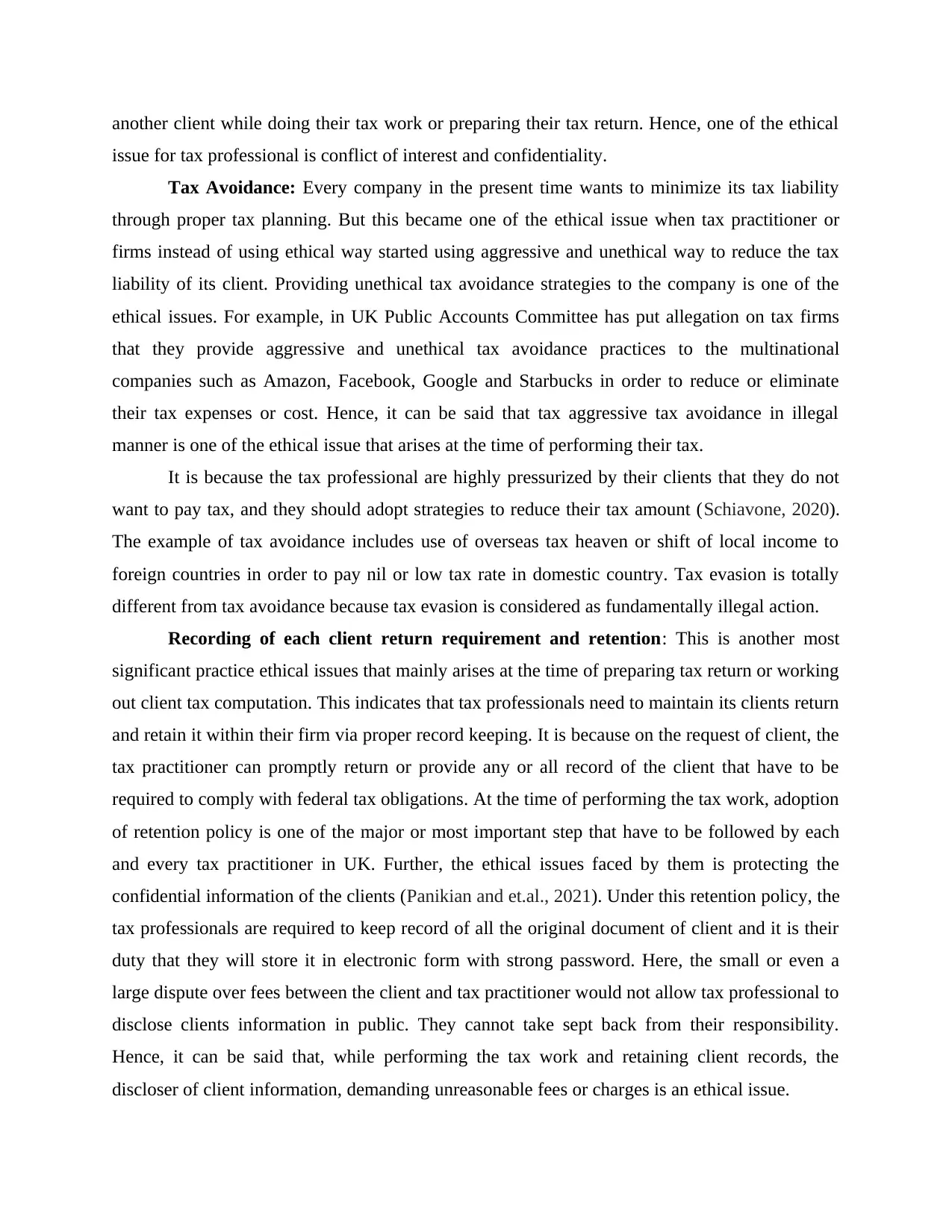
another client while doing their tax work or preparing their tax return. Hence, one of the ethical
issue for tax professional is conflict of interest and confidentiality.
Tax Avoidance: Every company in the present time wants to minimize its tax liability
through proper tax planning. But this became one of the ethical issue when tax practitioner or
firms instead of using ethical way started using aggressive and unethical way to reduce the tax
liability of its client. Providing unethical tax avoidance strategies to the company is one of the
ethical issues. For example, in UK Public Accounts Committee has put allegation on tax firms
that they provide aggressive and unethical tax avoidance practices to the multinational
companies such as Amazon, Facebook, Google and Starbucks in order to reduce or eliminate
their tax expenses or cost. Hence, it can be said that tax aggressive tax avoidance in illegal
manner is one of the ethical issue that arises at the time of performing their tax.
It is because the tax professional are highly pressurized by their clients that they do not
want to pay tax, and they should adopt strategies to reduce their tax amount (Schiavone, 2020).
The example of tax avoidance includes use of overseas tax heaven or shift of local income to
foreign countries in order to pay nil or low tax rate in domestic country. Tax evasion is totally
different from tax avoidance because tax evasion is considered as fundamentally illegal action.
Recording of each client return requirement and retention: This is another most
significant practice ethical issues that mainly arises at the time of preparing tax return or working
out client tax computation. This indicates that tax professionals need to maintain its clients return
and retain it within their firm via proper record keeping. It is because on the request of client, the
tax practitioner can promptly return or provide any or all record of the client that have to be
required to comply with federal tax obligations. At the time of performing the tax work, adoption
of retention policy is one of the major or most important step that have to be followed by each
and every tax practitioner in UK. Further, the ethical issues faced by them is protecting the
confidential information of the clients (Panikian and et.al., 2021). Under this retention policy, the
tax professionals are required to keep record of all the original document of client and it is their
duty that they will store it in electronic form with strong password. Here, the small or even a
large dispute over fees between the client and tax practitioner would not allow tax professional to
disclose clients information in public. They cannot take sept back from their responsibility.
Hence, it can be said that, while performing the tax work and retaining client records, the
discloser of client information, demanding unreasonable fees or charges is an ethical issue.
issue for tax professional is conflict of interest and confidentiality.
Tax Avoidance: Every company in the present time wants to minimize its tax liability
through proper tax planning. But this became one of the ethical issue when tax practitioner or
firms instead of using ethical way started using aggressive and unethical way to reduce the tax
liability of its client. Providing unethical tax avoidance strategies to the company is one of the
ethical issues. For example, in UK Public Accounts Committee has put allegation on tax firms
that they provide aggressive and unethical tax avoidance practices to the multinational
companies such as Amazon, Facebook, Google and Starbucks in order to reduce or eliminate
their tax expenses or cost. Hence, it can be said that tax aggressive tax avoidance in illegal
manner is one of the ethical issue that arises at the time of performing their tax.
It is because the tax professional are highly pressurized by their clients that they do not
want to pay tax, and they should adopt strategies to reduce their tax amount (Schiavone, 2020).
The example of tax avoidance includes use of overseas tax heaven or shift of local income to
foreign countries in order to pay nil or low tax rate in domestic country. Tax evasion is totally
different from tax avoidance because tax evasion is considered as fundamentally illegal action.
Recording of each client return requirement and retention: This is another most
significant practice ethical issues that mainly arises at the time of preparing tax return or working
out client tax computation. This indicates that tax professionals need to maintain its clients return
and retain it within their firm via proper record keeping. It is because on the request of client, the
tax practitioner can promptly return or provide any or all record of the client that have to be
required to comply with federal tax obligations. At the time of performing the tax work, adoption
of retention policy is one of the major or most important step that have to be followed by each
and every tax practitioner in UK. Further, the ethical issues faced by them is protecting the
confidential information of the clients (Panikian and et.al., 2021). Under this retention policy, the
tax professionals are required to keep record of all the original document of client and it is their
duty that they will store it in electronic form with strong password. Here, the small or even a
large dispute over fees between the client and tax practitioner would not allow tax professional to
disclose clients information in public. They cannot take sept back from their responsibility.
Hence, it can be said that, while performing the tax work and retaining client records, the
discloser of client information, demanding unreasonable fees or charges is an ethical issue.
⊘ This is a preview!⊘
Do you want full access?
Subscribe today to unlock all pages.

Trusted by 1+ million students worldwide
1 out of 40
Related Documents
Your All-in-One AI-Powered Toolkit for Academic Success.
+13062052269
info@desklib.com
Available 24*7 on WhatsApp / Email
![[object Object]](/_next/static/media/star-bottom.7253800d.svg)
Unlock your academic potential
Copyright © 2020–2025 A2Z Services. All Rights Reserved. Developed and managed by ZUCOL.





